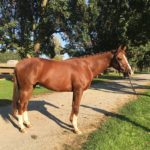It’s been a month since I left the sunny oasis of my little rent-a-farm in Wellington, where I spent this past season, and to be frank, it’s taken me awhile to collect my thoughts regarding the under-fire Thoroughbred show horse industry.

Talking about it seems much like debating politics and religion during family dinners. The second week I was at the Winter Equestrian Festival, while I was making my entries, I asked the secretary about the Thoroughbred jumper class. She didn’t know the answer to my question, so she stepped into an office to ask someone else. All I heard from the office was, “Who would bring a Thoroughbred to the WEF these days? And when will these incentive classes stop? Because they are just dumbing down the Thoroughbred, jumping them at 1m (3¹3²)².”
I was not in a position to argue; it was going to be our first show that week and to be honest, I didn’t know how my horse was going to enjoy the long hack to the show grounds and then, oh yeah, show in the class, haha… so I sat tight and really absorbed the rest of that conversation in the office.
I’m certain they were a bit old school, because they started talking about Joe Fargis, Rodney Jenkins, Kathy Kusner, Frank Chapot… then Idle Dice, Jet Run, Touch Of Class, Untouchable… and I could hear the sense of pride and respect that whoever was in that office had for those riders and those horses. These people even discussed the size of the jumps “back then,” but also talked about how Thoroughbreds today just can’t deal with today’s courses.
After leaving the WEF office with my number, I really recognized the task that was before me. I needed to show this horse well. Not necessarily win, but he needed to go in such a way that no one would look across the ring and say, “Oh look, that’s a Thoroughbred,” as if he or she had spotted Bigfoot on the show grounds.
[PHOTOGALLERY uniquename=”galleria-azur”]
The consensus I’ve heard over the last three years is that the Thoroughbred is a “breed of the past,” that Thoroughbred breeding has changed, that the courses are more technical these days and the Thoroughbred cannot handle them. Could we really come up with any more excuses?
Back in the ’80s, the American equestrian team started looking outside the States for horses, horses that were already going, up and running and easy to transition from the European style to American style—not that this was all bad, but as has been said before, not just by me, traveling to Europe was a cool thing to do, the show season had already started to change to a 12-month program for top riders, and they needed horses.
At that time, some of the greats in our training world—like Joe Green, Sonny Brookes, Lynn Jones, Kenny Smullen, Benny O’Meara, Vince Dugan and Allen Darner, to name a few—were disappearing. It had been their job to make up the horses for the top riders, but they were getting old and no one was replacing them; the torch had not been passed on to the next generation. So, in typical American fashion, we hopped on the figurative train to Europe and bought horses that had already been started— and we are still doing it today.
 Sonny Brookes
Sonny Brookes







